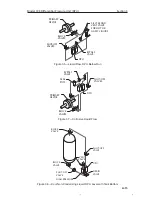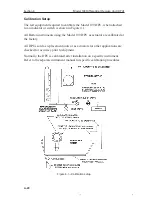
A-24
Section 4
Model 199 Differential Pressure Unit (DPU)
4. Install the range spring assembly, using a 1/2-inch open-ended wrench to
connect the push rod to the low-pressure bellows cup.
IMPORTANT: The range spring assembly consists of the range springs, kickoff spring
assembly, and the push rod. The assembly is furnished as a complete
and assembled unit.
5. Position range spring assembly over retainer posts and replace retainer
nuts.
6. Insert the tubing between the range springs and tighten inboard lock nut.
7. Zero the pointer by adjusting the spud on the push rod. Be sure that the
kickoff spring is not engaged during this operation.
8. Position the kickoff spring to prevent interference with the coil springs
and tighten the kickoff spring lock nut. If clearance is needed for the
wrench, note the position of the spud (measure with a scale or count
threads to the end of the push rod) and move the spud for the required
clearance. After the lock nut is tightened, return the spud to its original
position.
9. Check the back-clearance between the kickoff spring and the slot. Use a
wire feeler gage or comparable measuring device. The clearance between
slots will vary, but must be at least 0.005-in. to prevent interference with
instrument zero. Add or remove washers as required to obtain the proper
clearance. Tighten the lock nut securely.
10. Install the jam nut and lock the spud to the push rod. Hold with pliers.
If the spud was moved in step 8, return the spud to the proper position
before tightening the jam nut.
11. Apply 100 percent negative pressure to the high-pressure side of the DPU
and repeat the clearance check and adjustment described in step 9.
12. Apply 100 percent positive pressure to the high-pressure side of the DPU
and repeat the clearance check and adjustment described in step 9.
13. Release all pressure from the instrument, replace the low-pressure hous-
ing and install NEW bolts (new gaskets are also recommended). Torque
the bolts in accordance with
Table 4.2, page A-19
.
WARNING: Do not reuse housing bolts. Reuse of housing bolts, espe-
cially in critical applications like hydrogen sulfide and salt water expo
-
sures, can result in severe injury, death or substantial property damage
due to bolt failure.















































